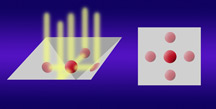 |
Heart of the orthogonal tracking microscope system developed at NIST is this nanoparticle solution sample well etched in silicon. Careful orientation of the silicon crystal makes it possible to chemically etch angled sides in the well so smooth they act as mirrors. In this configuration, four side views of a nanoparticle floating in solution (left) are reflected up. A microscope above the well sees the real particle (center, right) and four reflections that show the particle’s vertical position. |
(NIST: Gaithersburg, Maryland) -- A clever new microscope design allows nanotechnology researchers at the National Institute of Standards and Technology to track the motions of nanoparticles in solution as they dart around in three dimensions. The researchers hope that the technology, which NIST plans to patent, will lead to a better understanding of the dynamics of nanoparticles in fluids and, ultimately, process control techniques to optimize the assembly of nanotech devices.
…
Add new comment